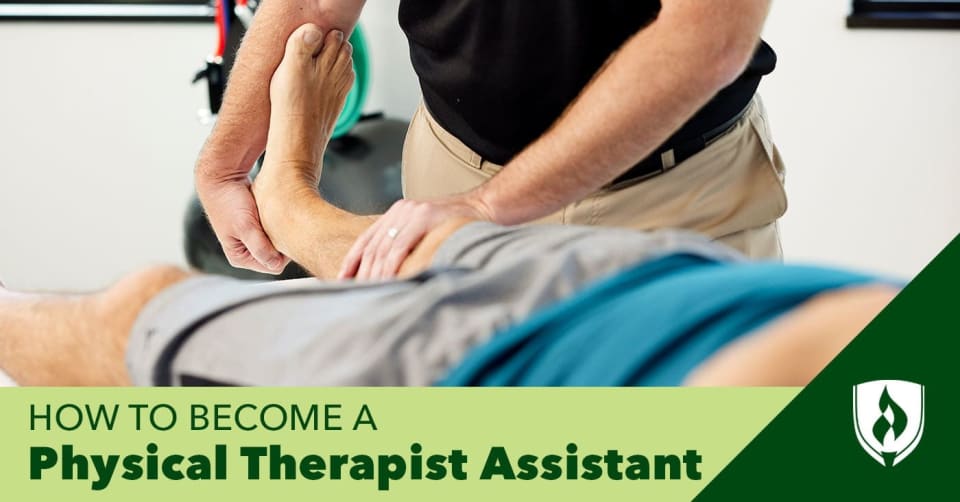
If you have a passion for being active and a heart for helping others, then it's no surprise you're considering becoming a physical therapist assistant (PTA) - sometimes referred to as a physical therapy assistant.
Not only do these detail-oriented health care pros have the rewarding opportunity to help improve the quality of life of others, but they are also desperately needed in today's health care system.
If you're at all intrigued by this in-demand career, read on to learn more about why it's appealing, what it entails and how to become a physical therapist assistant. Unsure of the difference between a physical therapist assistant and an aide? Check out the difference between what a Physical Therapy Aide vs. Assistant is.
Ready to launch your career as a Physical Therapist Assistant?
Explore our accredited PTA programWhy become a physical therapist assistant?
There's a lot to like about the role of a physical therapist assistant. According to the U.S. News & World Report job rankings, it is considered a top health care support job.
This recognition was earned by weighing career factors like median annual salary, unemployment rate and future growth along with job satisfaction elements such as stress level and work-life balance.
Using Exercise and Movement
Generally speaking, physical therapist assistants tend to enjoy what they do. And that's not hard to believe, considering their job revolves around helping patients holistically, using exercise, movement and an intricate understanding of the human body to help reduce pain and gain mobility.
But beyond the helping nature of the work, there are two significant economic factors that make physical therapist assistant jobs enticing.
What is the job outlook for physical therapist assistants?
When it comes to health care workers, most people probably don't think of physical therapist assistants. But the truth is that they play a critical role in the health care system. This is evident in the rapid growth in the field.
In fact, PTAs are among the top 20 fastest growing occupations in the next decade, according to the U.S. Bureau of Labor Statistics,1 so the projected job outlook is encouraging.
Physical therapy assistant jobs projected to rise
Physical therapist assistant jobs are projected to increase 24 percent through 2031, which is four times faster than the Bureau of Labor Statistics reported average for all occupations.1
Like many other health care jobs, the aging baby boomer generation is creating a spike in demand as retirements and age-related health issues grow.
Physical therapists are also expected to rely more heavily on PTAs in order to reduce the cost of physical therapy services.
Now that you're aware of the growth and earning potential for PTAs, let's take a closer look at the job duties and path to become one.
What does a physical therapist assistant do?
Physical therapist assistants work in teams and treat patients who have injuries or medical conditions that limit their mobility or make it difficult to perform everyday tasks and activities, according to the American Physical Therapy Association (APTA). PTAs accommodate patients' schedules for optimal treatment plans.
PTAs typically observe patients before, during and after therapy. They help them perform therapeutic exercises and therapeutic interventions to test their physical stamina, devise a possible treatment plan, and treat them through massage and stretching techniques. Physical therapist assistants also educate patients and family members about post-treatment care. Additionally, they may assist onsite physical therapist aides.
Some common activities that PTAs assist patients with include: stretching, ultrasound therapy, therapeutic massage, balance and coordination training, electrical stimulation or heat and ice treatments.
How do you become a physical therapist assistant?
Now that you know a bit more about the job and its benefits, take a look at your step-by-step guide on how to become a physical therapist assistant.
Start your PTA journey today.
Learn more about our Associate's Degree in Physical Therapist AssistantStep 1: Earn a Physical Therapist Assistant Associate degree
All states require PTAs to have an Associate degree from an accredited program, according to the BLS. Earning a degree may sound daunting, but some PTA training can be completed in as few as 18 months.2 This formal education consists of courses, lab work and clinical training.
Step 2: Pass the licensing exam
All states except Colorado and Hawaii require PTAs to be licensed in addition to holding a degree.
Once applicants have graduated from a PTA program, they're eligible to take the National Physical Therapy Exam for physical therapist assistants. Once you pass this exam, you'll be a licensed PTA.
It's important to thoroughly prepare for the National Physical Therapy Exam (NPTE) before taking it. Though retakes are available, you may only take the exam three times in one year or six times total.
More details on the NPTE can be found at The Federation of State Boards of Physical Therapy website. Depending on the state, physical therapist assistants may also need to take continuing education courses to maintain their license.
Step 3: Brush up on these in-demand PTA skills
After earning your Associate’s degree, fine-tuning the necessary technical skills and passing the NPTE, you're nearly ready to begin your career as a PTA and make a difference in the health care industry.
But before rushing into the career search process, it's helpful to know what exactly employers are looking for so you can come prepared to put your best foot forward.
We used real-time job analysis software to examine more than 30,000 physical therapist jobs posted over the past year.3 The data helped us identify the top skills employers are seeking:
- Treatment planning
- Rehabilitation
- Patient care
- Cardiopulmonary resuscitation (CPR)
- Home health
- Patient and family education
- Therapy
- Scheduling
While a great physical therapy assistant program is designed to equip you with the necessary technical skills, a little extra proficiency in these skill areas will help your resume stand out to employers. You might also consider getting involved in extracurricular activities to polish your skills.
Coaching youth sports is an excellent option for anyone looking to develop their training and motivational skills and volunteering at nursing homes would be an excellent way to show your interest in working with aging populations.
Step 4: Sharpen your resume and interview skills and start applying
No matter the job you're applying for, taking the time to update and polish your resume will help improve your odds of getting a call back. You'll also want to work on your interviewing skills while on your search.
As you go into your job search, understand what your preferred practice areas are—do you want to work with athletes? The elderly? People with disabilities? There may be several job openings for each of those specialties. While it might not be practical in all locations, narrowing your search and tailoring your resume and interview answers to your preferred physical therapy specialty area can help you prioritize and focus yourself while searching.
The importance of communication skills for physical therapist assistants
Most physical therapist assistants have strong communication skills so they can effectively convey information to patients and physical therapists. As a PTA, you will need to listen carefully to the physical therapist's instructions and relay those directions to the patient.
You must also be able to observe and assess the patient's progress and report any concerns to the physical therapist. Being an effective communicator helps build trust between you, the physical therapist, and the patient, resulting in better patient outcomes and a more positive health care experience.
Physical therapist assistant specializations
As a physical therapist assistant, you have the opportunity to specialize in a particular area of physical therapy. Some popular specializations include orthopedics, pediatrics, geriatrics, sports medicine, and neurology.
These specialized areas allow PTAs to focus on specific patient populations or types of conditions, providing more targeted and effective care. Pursuing a specialization may also lead to additional job opportunities and the potential for higher salaries, as your expertise in a specific field becomes increasingly valuable to employers.
The value of continuing education for physical therapist assistants
Continuing education is essential for physical therapist assistants to stay current with the latest research, techniques, and best practices in the field. Many states require PTAs to complete a certain number of continuing education hours to maintain their license.
Even if not mandated, pursuing continuing education demonstrates your dedication to your profession and your commitment to providing the best possible care for your patients. This can lead to career advancement opportunities and increased job satisfaction. In addition to formal education at an accredited PTA program, PTAs must also take specialized laboratory courses to learn basic life support, human anatomy and the medical terminology that goes with the territory.
Physical therapist assistant work settings
Physical therapy assistants work in a variety of settings, including hospitals, outpatient clinics, nursing homes, home health agencies, and schools. Each work setting offers unique challenges and benefits, and your preferences may change as your career progresses. As a PTA, it's important to be adaptable and open to new experiences, as this flexibility can lead to diverse job opportunities and professional growth.
The role of technology in physical therapy
As technology advances, it is increasingly integrated into the field of physical therapy. Physical therapist assistants must stay current with these developments to provide the best possible care and treatment plans for their patients.
This may include using software programs for documentation and billing, incorporating telehealth services, or utilizing innovative treatment modalities and therapeutic devices such as virtual reality and wearable devices. Embracing technology can improve patient outcomes, streamline processes, and enhance the overall quality of care.
Building a supportive network in the physical therapy field
Networking is crucial for physical therapist assistants to establish connections, gain new insights, and advance their careers. Joining professional organizations, attending conferences, and participating in local physical therapy events can help you build relationships with peers, mentors, and potential employers. A strong network can provide valuable resources, such as job opportunities, professional advice, and support throughout your career as a physical therapist assistant.
The importance of cultural competency for physical therapist assistants
Cultural competency is an essential skill for physical therapist assistants to effectively serve diverse patient populations. Developing cultural competency means understanding and respecting the cultural backgrounds, beliefs, and values of your patients.
This understanding allows you to better communicate with patients, build trust, and create a more inclusive and comfortable therapeutic environment. Participating in cultural competency training and actively engaging with individuals from different backgrounds can help you develop these crucial skills and enhance the quality of care you provide.
The role of ethics in physical therapy practice
As a physical therapist assistant, you will face ethical dilemmas and decisions throughout your career. It is essential to understand and adhere to the ethical principles and professional standards set forth by organizations such as the American Physical Therapy Association (APTA). Workshops or courses related to behavioral sciences are a plus.
These principles include respect for patient autonomy, beneficence, non-maleficence, and justice. By maintaining a strong ethical foundation, you will ensure the well-being and safety of your patients, foster a positive therapeutic relationship, and uphold the integrity of the profession.
Promoting health and wellness as a physical therapist assistant
In addition to helping patients recover from injuries and regain mobility, physical therapist assistants play a crucial role in promoting overall health and wellness. Educating patients on injury prevention, proper body mechanics, and healthy lifestyle choices can help them avoid future issues and maintain long-term well-being.
As a PTA, staying up-to-date with the latest health and wellness research will enable you to provide patients with accurate and relevant information, empowering them to take charge of their health and make informed decisions. By fostering a holistic approach to patient care, you can contribute to the overall health and quality of life of the individuals you serve.
Start your physical therapist assistant career
Does this outline of how to become a physical therapist assistant look like the path to the satisfying career you've been searching for? Do you have your high school diploma, and you looking to further your education? Are you ready to make a difference in the health care industry? If so, then you're ready to start researching to find the best training for you. Physical therapists play a vital role in society.
Learn more about what to look for in a quality program in our article, “Physical Therapy Assistant Programs: Key Factors to Consider.”
Related Articles:
- 5 Reasons to Become a Physical Therapist Assistant in Florida
- Physical Therapist Assistant vs. Physical Therapy Aide: Breaking Down the Difference
- Career Change: 8 Reasons Why Being a Physical Therapist Assistant Is Worth the Switch
EDITOR'S NOTE: This article was originally published in June 2016. It has since been updated to include information relevant to 2023.
1Bureau of Labor Statistics, U.S. Department of Labor, Occupational Outlook Handbook, [information accessed May 2023]. www.bls.gov/ooh/. Employment conditions in your area may vary.
2Completion time is dependent on the number of transfer credits accepted and courses completed each term.
3Burning-Glass.com (analysis of 31,842 physical therapist assistant jobs, Apr. 01, 2019 – Mar. 31, 2020).
Graduation from a physical therapist assistant education program accredited by the Commission on Accreditation in Physical Therapy Education (CAPTE), 3030 Potomac Ave., Suite 100, Alexandria, VA 22305-3085; phone; 703-706-3245 [email protected] is necessary for eligibility to sit for the licensure examination, which is required in all states.
Graduation from a physical therapist assistant education program accredited by the Commission on Accreditation in Physical Therapy Education (CAPTE), 3030 Potomac Ave., Suite 100, Alexandria, VA 22305-3085; phone; 703-706-3245 [email protected] is necessary for eligibility to sit for the licensure examination, which is required in all states.
Accredited programs:
The Physical Therapist Assistant Program at Rasmussen University – Brooklyn Park/Maple Grove is accredited by the Commission on Accreditation in Physical Therapy Education (CAPTE), 3030 Potomac Ave., Suite 100, Alexandria, Virginia 22305-3085; phone: 703-706-3245; email: [email protected]; website: https://www.capteonline.org
The Physical Therapist Assistant Program at Rasmussen University – Ocala is accredited by the Commission on Accreditation in Physical Therapy Education (CAPTE), 3030 Potomac Ave., Suite 100, Alexandria, Virginia 22305-3085; phone: 703-706-3245; email: [email protected]; website: https://www.capteonline.org. If needing to contact the program/institution directly, please call 833-606-1911 or email [email protected].




